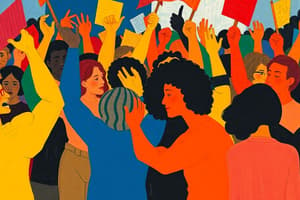Podcast
Questions and Answers
What is collective behavior?
What is collective behavior?
Activity involving a large number of people that is unplanned, often controversial, and sometimes dangerous.
What is a collectivity?
What is a collectivity?
A large number of people whose minimal interaction occurs in the absence of well-defined and conventional norms.
What is a crowd?
What is a crowd?
A temporary gathering of people who share a common focus of attention and who influence one another.
What is a mob?
What is a mob?
What is a riot?
What is a riot?
What is contagion theory?
What is contagion theory?
What are characteristics of emotional contagion?
What are characteristics of emotional contagion?
Explain similarity of emotional moods in relation to emotional contagion.
Explain similarity of emotional moods in relation to emotional contagion.
Explain focused attention in relation to emotional contagion.
Explain focused attention in relation to emotional contagion.
Explain distraction from self in relation to emotional contagion.
Explain distraction from self in relation to emotional contagion.
Explain suggestibility in relation to emotional contagion.
Explain suggestibility in relation to emotional contagion.
Explain reciprocal stimulation in relation to emotional contagion.
Explain reciprocal stimulation in relation to emotional contagion.
Explain selective perception in relation to emotional contagion.
Explain selective perception in relation to emotional contagion.
Explain homogeneity of members in relation to emotional contagion.
Explain homogeneity of members in relation to emotional contagion.
What is convergence theory?
What is convergence theory?
What is emergent norm theory?
What is emergent norm theory?
What is mass behavior?
What is mass behavior?
What is a rumor?
What is a rumor?
What is gossip?
What is gossip?
What is public opinion?
What is public opinion?
What is propaganda?
What is propaganda?
What is fashion?
What is fashion?
What is a fad?
What is a fad?
What is panic?
What is panic?
What is mass hysteria?
What is mass hysteria?
What is moral panic?
What is moral panic?
Flashcards are hidden until you start studying
Study Notes
Collective Behavior
- Involves a large number of people engaging in unplanned and often controversial activities.
- Can sometimes lead to dangerous situations due to the lack of organization.
Collectivity
- Refers to a large group of people interacting minimally without established norms.
Crowd
- A temporary gathering with a shared focus, where individuals can influence one another’s feelings and actions.
Mob
- An emotional crowd pursuing violent or destructive goals, characterized by a lack of control.
Riot
- A social eruption filled with emotional and violent actions that lack direction.
Contagion Theory
- Proposed by Gustave Le Bon, this theory suggests crowds create a hypnotic influence on members, who may act irrationally due to anonymity and emotional exchange.
Emotional Contagion Characteristics
- Homogeneity of Members: Crowd members share similar characteristics.
- Similarity of Emotional Moods: Collective emotions are aligned among members.
- Focused Attention: Collective focus on one singular event or stimulus.
- Distraction From Self: Crowd influences behaviors outside of personal norms.
- Suggestibility: Members may adopt suggestions on how to behave from others.
- Reciprocal Stimulation: Interaction where influence flows between members.
- Selective Perception: Individuals notice and reinforce only perspectives aligning with their views.
Convergence Theory
- Suggests crowd behavior is shaped by individuals with similar intentions who come together, contrasting with the contagion theory.
Emergent Norm Theory
- Developed by Ralph Turner and Lewis Killian, it highlights that while social behavior can vary, patterns can emerge from collective interests.
Mass Behavior
- Collective actions among individuals dispersed over wider geographical areas.
Rumor
- Informal and uncontrolled information spread, often vocally within social circles.
Gossip
- Rumors specifically concerning personal matters of others.
Public Opinion
- The collective attitudes people hold regarding controversial issues.
Propaganda
- Information curated to influence and shape public views.
Fashion
- Social patterns widely accepted by a large number of people as preferred trends.
Fad
- Brief and enthusiastic adoption of unconventional social patterns.
Panic
- A collective response driven by fear to perceived threats, leading to irrational and often destructive behaviors.
Mass Hysteria
- A widespread reaction to imagined or real events leading to irrational fear and frantic behaviors.
Moral Panic
- A societal response characterized by disproportionate reactions to perceived threats or events, often fueled by collective fears.
Studying That Suits You
Use AI to generate personalized quizzes and flashcards to suit your learning preferences.



